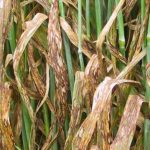 Earlier this summer I looked at an interesting project that was using drones to monitor the health and wellbeing of crops. The project is measuring the stress levels of plants, which researchers believe could result in a reduction in insecticide use.
Earlier this summer I looked at an interesting project that was using drones to monitor the health and wellbeing of crops. The project is measuring the stress levels of plants, which researchers believe could result in a reduction in insecticide use.
It’s widely believed that plant stress makes them more susceptible to attacks and infections, with the obvious implications of this for the commercial viability of the farm.
Now, a Swiss team have developed a system that they believe can learn to recognize specific plant diseases, which they think could pave the way for automatic visual detection, either by smartphones or from drone based cameras.
The plant doctor
The approach, which is documented in a recent paper, could have particular benefits for farmers in developing countries who lack access to more traditional means of diagnosing the health of their crops.
“Global food security is threatened by a number of factors, not the least of which is plant diseases that can reduce yields or even wipe out a crop,” the authors say.
The economic and social impact of a disease ridden harvest can be disastrous for smallholders whose very existence often depends on the bounty of their crops. Such smallholdings make up around 80% of agricultural production in the developing world.
“Identifying a disease correctly when it first appears is a crucial step for effective disease management,” the authors continue. “With the proliferation of smart phones and recent advances in computer vision and machine learning, disease diagnosis based on automated image recognition, if technically feasible, could be made available on an unprecedented scale.”
Learning what healthy looks like
At the heart of the system is a neural network that used deep learning to analyze over 53,000 images of both healthy and diseased plants so that it could accurately identify patterns in what they see.
We have already seen a growth in consumer applications of such image recognition technology, with Facebook being perhaps the most well known example, but it’s great to see the technology applied in such a worthwhile way as this.
The images used in the project were derived from PlantVillage, which is an online database of plant disease that was established in 2012. It contains 14 crop species and 26 different diseases, with the algorithm tested on how accurate it was at classifying both crop type and disease type.
“Our goal was to classify crop species and the presence and type of disease on images that the model had not seen before,” the authors say. “Within the PlantVillage data set, the model achieved an accuracy rate as high as 99.35 percent, meaning it correctly classified crop and disease from 38 possible classes in 993 out of 1,000 images.”
Whilst the initial costs involved are significant, the team believe that once the model has been trained, the process is both very fast and very cost-effective, thus rendering it a possible smartphone app, or perhaps even a drone based service.
With the smartphone an almost ubiquitous device around the world, providing this sort of capability for them would undoubtedly be valuable to farmers the world over. Certainly a project to watch with interest.